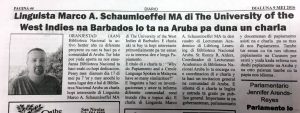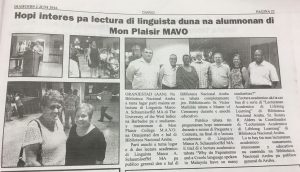Why do Papiamento and a Creole Language Spoken in Malaysia have so many similarities?
Two presentations at the Biblioteca Nacional Aruba, Oranjestad, Aruba
Lecture in the series “Lifelong Learninig – Academic Lectures” – May, 17 2016
Diario, 09 May 2016, p. 44

Invitation

Diario, 2 June 2016, p. 23

Some pictures of the two events:
 |
 |
 |
 |
 |
 |
 |
Abstract
Why do Papiamento and a Creole Language Spoken in Malaysia have so many similarities?
The aim of this presentation is to make relevant considerations on the origin of Papiamento (PA). The discussion on the origins of PA still is object of controversy. Some scholars classify it as a creole language of Spanish origins and others as a creole of Portuguese origins. Recent historical and linguistic evidence suggests that PA owes its origins to the West African Portuguese creoles (cf. Jacobs, Origins of a Creole 2012).
In this presentation, the author provides further evidence in favour of the Portuguese origins of PA by doing an investigation on the historical and linguistic links existing between PA and Papiá Kristang (PK). Historical links are important, but linguistic data is the most reliable evidence of possible genetic ties between creoles. It may seem strange to compare a creole language that developed in Southeast Asia with a creole spoken in former Dutch colonies in the Caribbean, since they are worlds apart. PK, a Portuguese creole spoken in Malacca, Malaysia, is not directly linked to the West African Portuguese creoles like PA, but is a Portuguese creole undoubtedly unrelated to Spanish. This fact turns PK into an interesting tool of comparison to verify possible similarities and correspondences in the PA and the PK grammatical categories, and to establish if PA carries basic Portuguese creole features. The analysis is based on linguistic data from grammars, descriptions and texts in PA and in PK. The focus are grammatical similarities and correspondences that are observed in the structure of both creoles, and the implications these have to determine a possible common origin.
To achieve this objective, a comparison of important linguistic features in the two languages will be made. The evidence suggests that the origins of PA cannot be completely analysed and understood if vital historical and linguistic links to the Portuguese language are ignored. It remains open to discussion whether these ties were solely formed via West Africa and the Portuguese creoles spoken there or not. However, this presentation intends to discard any hypothesis that excludes the fundamental role Portuguese and Portuguese creoles played in the formation of PA.